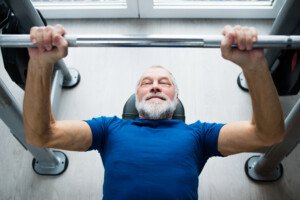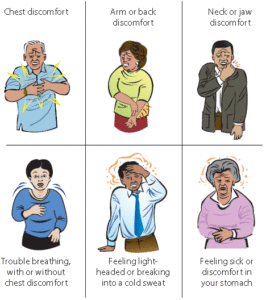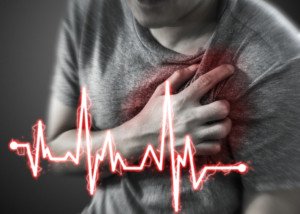Strength training will lower heart attack and stroke risk.
The big question is how much time you must do this each week in order to reap cardiovascular benefits.
Iowa State University researchers wanted to find out how many hours a week minimum of lifting weights were required to lower one’s risk for a heart attack or stroke.
The study’s result isn’t in hours; it’s in minutes: under 60 minutes – per week.
However, this doesn’t translate to mindlessly picking up and putting down five-pound dumbbells or staying at only 45 pounds on the lat pull-down machine month after month.
You actually have to weight train.
Intensity, strategy and focus are far more important than lots of time when it comes to heart health.

Shutterstock/Halfpoint
Associate professor of kinesiology, DC (Duck-chul) Lee, says that two sets of bench presses once a week will positively affect cardiovascular health.
But again, coming from a former personal trainer, I need to point out that merely going through the motions isn’t enough.
I don’t endorse straining, either, if your goal is simply to have a healthier heart.
But your strength training sets should feel like WORK – from the very first repetition.
How the Study Was Done
• Lee et al analyzed data from about 13,000 subjects in the Aerobics Center Longitudinal Study.
• Three outcomes were measured: non-fatal cardiovascular events like heart attack; all cardiovascular events including fatal; and death from any cause.
• It was found that strength training cut the risk of all three types of outcomes.
Must You Bench Press to Lower the Risk of Heart Attack or Stroke?
No. It was just an example. But it was a good example, because the bench press engages multiple muscle groups.
Lee points out that muscle fibers don’t know the difference between lifting a dumbbell, digging in the yard or carrying heavy shopping bags.
I see a problem with this comparison. Relying on the routine activities of day-to-day living as your weight training guarantees inconsistency, long periods in between the digging or carrying, and lack of a progressive component.
Grocery bags feel heavy only to people with weak muscles. A trained body will not perceive grocery bags as heavy enough to count as a weight workout.
So if they’re heavy to you, you need to strengthen your muscles with resistance equipment.
Next, you need to employ progressive resistance – using more resistance over time.
A grocery bag will never get heavier. But you can accurately keep track of how much weight you’re lifting and easily increase the weight load when you use equipment.
It’s odd that Lee endorses daily activities, as though these are a built-in way to lower heart attack risk.
If they were, there’d be no need to “strength train” to lower the risk of heart attack because everyone already IS strength training simply by doing chores and running errands!
This is absurd. Do not fall for it.
USE EQUIPMENT (barbells, dumbbells, kettlebells, pulley machines, weight plate machines, heavy balls, tension bands, even your own bodyweight such as for jump squats or pushups).

Freepik
Bottom line: Housework, errands and carrying things around the house or parking lot do not count as strength training, especially when you could go weeks before the next time you carry a heavy shopping bag or dig a hole in your yard.
At least with using equipment you can schedule a for-sure weekly regimen of under an hour and measure your progression.
Progressive training is crucial because it will keep you motivated.
Getting stronger over time (no need to strain or try to be the strongest in the gym) will also do wonders for your bones, joints, knees and back; help prevent type 2 diabetes and high blood pressure; and help ensure that in old age you’ll be shopping for a new golf club rather than a new cane.
Lee’s report appears in the 2018 Medicine & Science in Sports & Exercise.


























